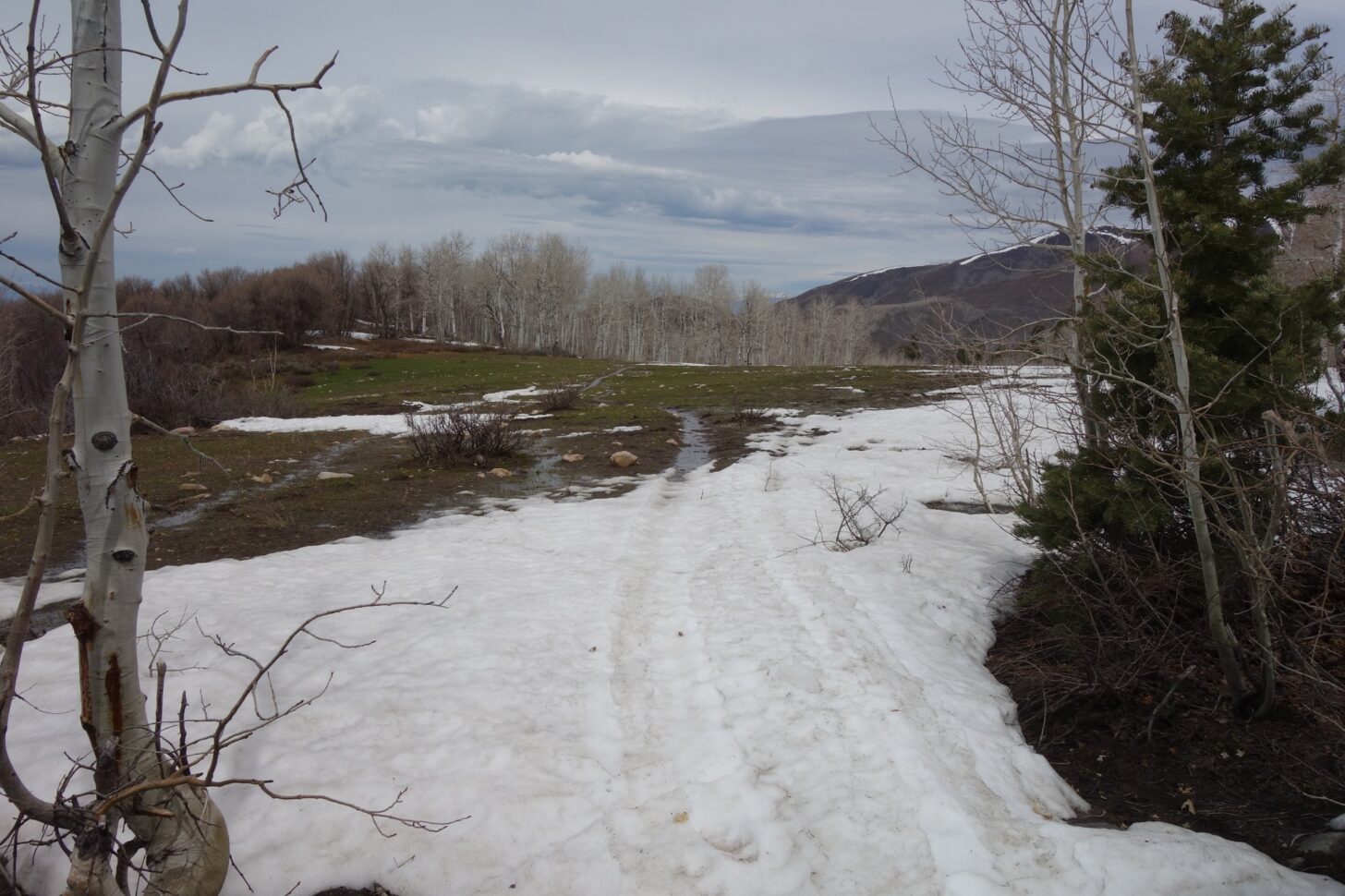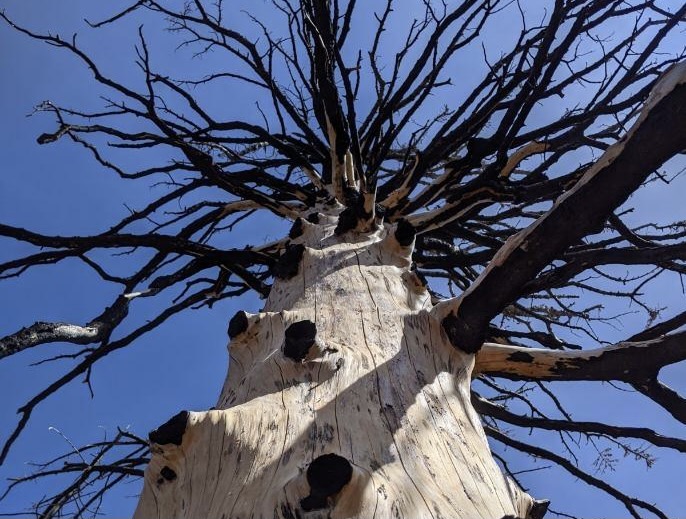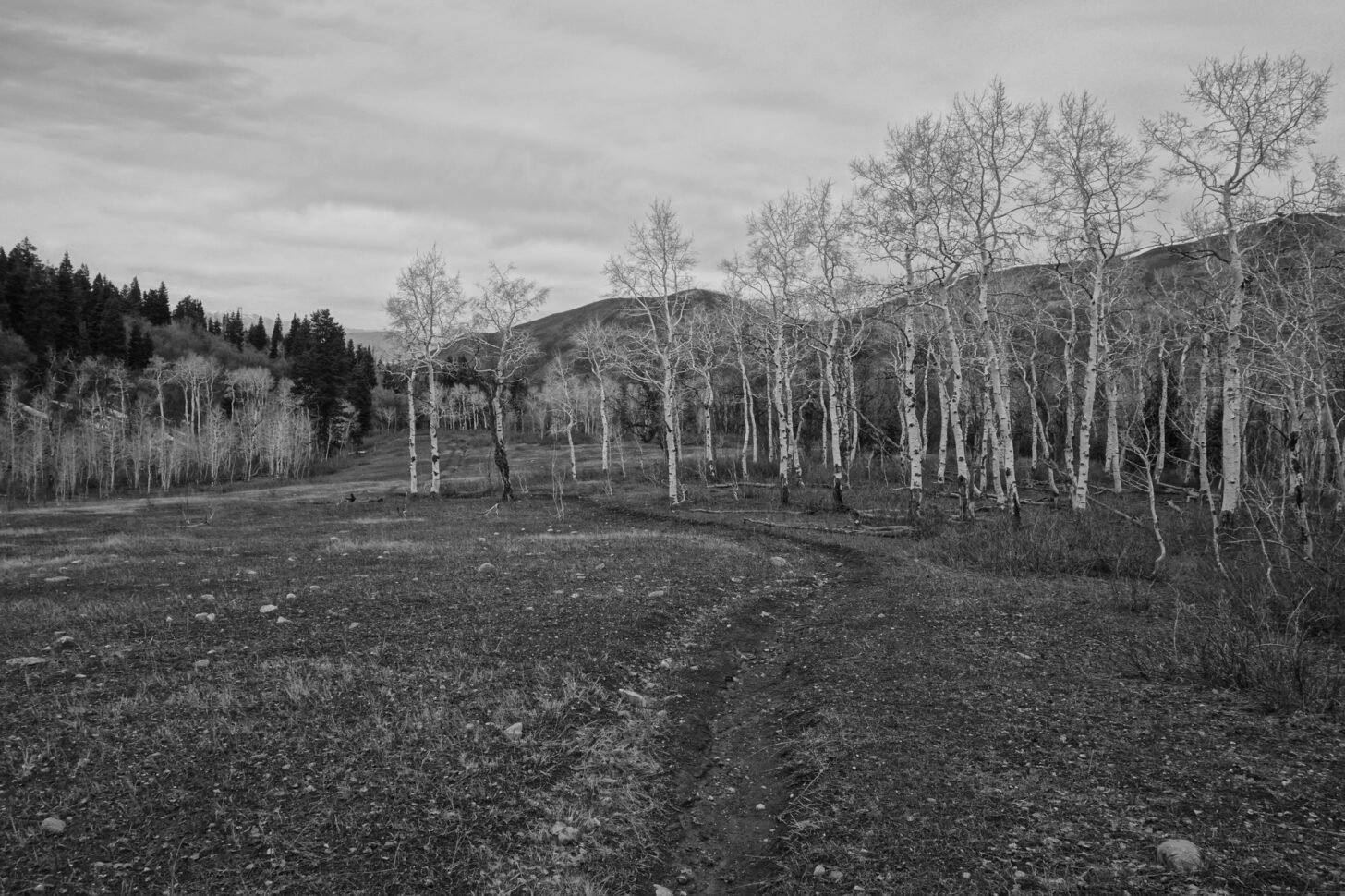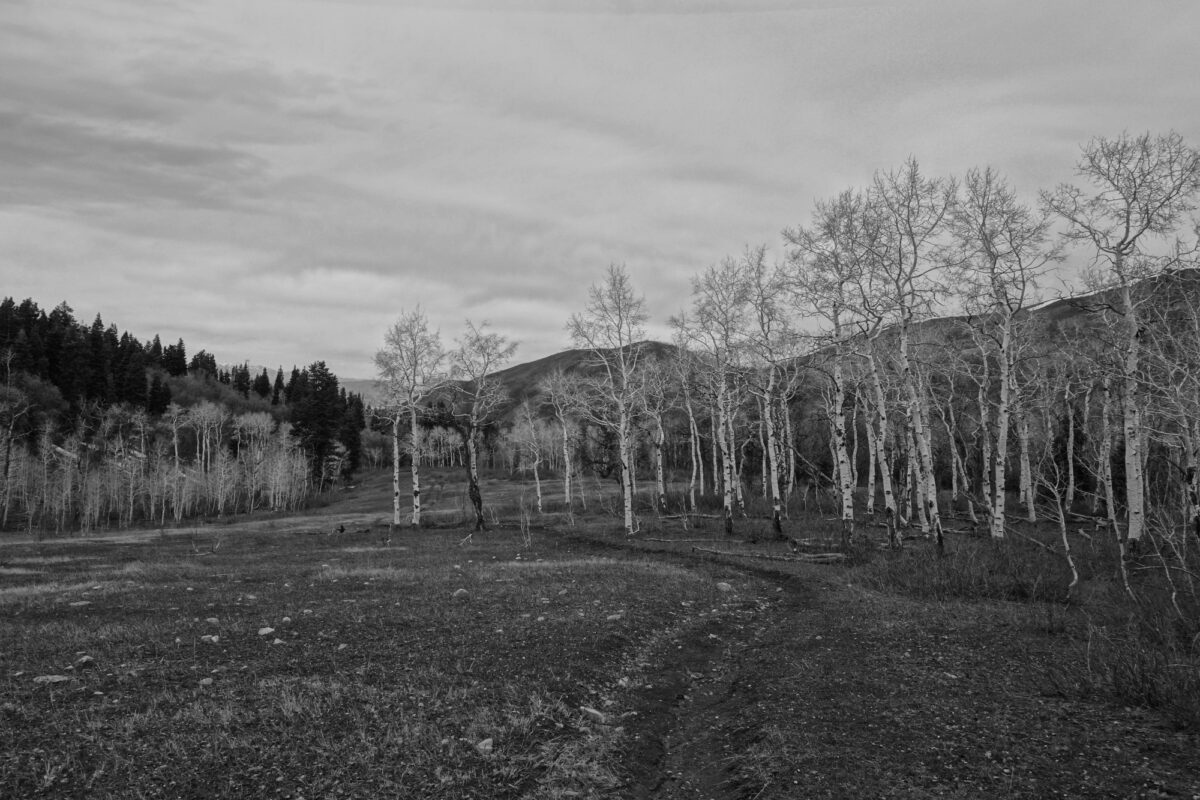We knew the gate would be closed and that we would have to walk the road for at least a mile to reach the trailhead, but that was part of the appeal. Rachel and I chose this area, the Payson Lakes area, an hour-and-a-half south of Salt Lake City because within weeks it would be swarming with people. We also chose it because, as Rachel reminded me, it is her backyard, and she feels a commitment to learning as much as she can about the plants and animals with which she shares it. And what better time to observe a place than transition season?

The gate kept all but walkers and cyclists out. Once open, cars, RVs, and off-road vehicles would stream through, spreading across the mountain like ants over a Swedish fish dropped on a trail.
Though only April, the day was hot. I walked in my typical uniform, shorts and a long-sleeve shirt, while Rachel wore a long linen dress, because, why not? Payson Creek was particularly talkative, rambling on about the sun that freed it once again and the stones underneath. I took a mental note, “April, 30th 2021, too hot for the end of April.”
Around a mile in, we found the Grotto Trailhead on the left and took it through burned aspens and firs to its end. Here the creek plunged into a red, conglomerate, broken cistern and roared inside it, filling the air with tiny specks of water. Removing our packs and squatting in the river stones at the edge of the pool within the grotto, we watched a streak of sunlight break into prisms on the edge of the waterfall.

Leaving the creek, we climbed a steep hill through the burn and this year’s new growth. We paused to catch our breath and to touch mallow and elderberry, larger and more exuberant than we would have anticipated after only two years of growth since the fire. Hope in every leaf, every stalk we pressed between our fingers. When we reached the road it was still fairly steep, so when two mountain bikes rocketed past us, we were, for a split second, alarmed by their superhuman strength. Then we noticed the oversized bottom brackets common to E-bikes and their uphill speed made sense. We watched them turn into a dirt parking area, speed toward our next trail, and then fly effortlessly into the woods.
We stepped off the road and into the trees, tromping through soggy meadows and then up a small hill overlooking more soggy meadows. The wind must have been in our favor because the sleeping wapiti (elk) below us showed no sign of catching our scent or hearing our voices. We observed them for several minutes before walking toward them again, within fifty feet finally rousing them from their siesta. Looking back occasionally, they trotted swiftly across the meadow and into the still-bare aspens at the edge of the hill and descended out of sight. I logged this landscape abstractly somewhere in my mind as wapiti country.
The pillows of snow on the edges of the flooded meadow were retreating quickly. Something about the speed of the water moving down the trail seemed too fast, and I noted this, too. The early-season heat had everything in a rush, an unnecessary hurry. “Slow down,” I thought.
This was transition season, and we came here just to see it. We took note of the quickly melting snow, the day’s warmth, the presence of wapiti. We logged in our minds the bright green, alien corals of emergent false hellebore that dotted the meadow. We took mental snapshots of avalanche lilies and other yellow flowers we couldn’t yet name. When we reached more snow, so much that we were post-holing and there was hardly any bare ground on which to walk, I took a look at the map and noted the elevation, about 8,000 feet. At an ephemeral (probably seasonal) pond, frog sounds echoed through the firs and aspens, mixing with the sound of rushing water, and I again looked at my map and noted the elevation, about 8,200 feet, cross-referencing it with the date again, April 30th, 2021.

I was taking these notes because this is how I prefer to backpack. I feel that through building this knowledge I can become a better citizen of the places where I recreate, and this process of becoming a better citizen of place can become the recreation itself. I have talked about this before, particularly in the essay I wrote last year, “Backpackers Should be Amateur Naturalists,” and again in my recent piece on Bear’s Ears, but I wanted to address it again, this time through a Leopold lens because he insists that I could be doing more.
The final essay in Aldo Leopold’s A Sand County Almanac is called “Conservation Esthetic.” In it, he lays out five distinct grades of recreation with a hierarchy that isn’t as simple as saying that canoeing is better than four-wheeling. The levels of recreation are as follows (1 being the lowest form of recreation, and 5 being the highest):
- trophy hunting
- seeking solitude
- seeking fresh air and change of scene
- nature study
- sense of husbandry
Trophy hunting is described as, “the physical objects that the outdoorsman may seek, find, capture, and carry away. In this category are wild crops such as game and fish, and the symbols or tokens of achievement such as heads, hides, photographs, and specimens.” Leopold, writing this in the early part of the 20th century, is mostly worried about the mass use of resources. The next two grades are pretty self-explanatory. These describe the recreationist who walks into the woods to escape from it all. And the fourth, nature study, is exactly what I was talking about when I said that backpackers should be amateur naturalists.

Every single one of my backpacking experiences falls within the first four grades. I take tons of photos, which is a form of trophy hunting. Sometimes I try to move as fast as possible to close a loop within a short amount of time, to prove that my body and mind are up to the task. This too, I’d place in the trophy hunting category, as I document my accomplishment. I seek solitude, fresh air, and to get as far away from my computer as possible for as long as I realistically can. And finally, all of my jotting of observations in notebooks falls into Leopold’s fourth category of recreation, that of nature study.
He reminds us that all of these forms of recreation are simply attempts to reenact long-gone ways of life. “The duck-hunter in his blind and the operatic singer on the stage, despite the disparity of their accouterments, are doing the same thing. Each is reviving, in play, a drama formerly inherent in daily life. Both are, in the last analysis, esthetic exercises,” Leopold writes.
Sheepishly, I have to admit that my favorite pastime, backpacking, is an esthetic exercise, too. I walk out into the land and sleep amongst the stones, wind, snowmelt, and animals to get some inkling of the feeling of nomadism maybe. I probably take notes because, if I was really subsisting off of the place, my observations would be crucial to a reciprocal relationship with the land, a mutual survival. I’m putting on a play, one that opens a channel to thousands of years of human experience, and there is value to this, no doubt, but it is still a play.

The fifth grade of recreation, a sense of husbandry, seems to land outside of this reenactment, as it asks of us a material engagement in the environment. Leopold says that a sense of husbandry, “is unknown to the outdoorsman who works for conservation with his vote rather than with his hands. It is realized only when some art of management is applied to land by some person of perception.” He’s saying that rarely does an outdoorsperson get to experience and find enjoyment in a sense of husbandry, for its enjoyment is reserved for those who own and work their land, and for folks such as land managers and forestry technicians.
Leopold is arguing that the first four grades with their inherent dissociation from the land, and the relative nonexistence of the fifth among recreationists, pose a huge threat to the lands on which we recreate. The lower recreation grades,
“consume their resource base; the higher grades, at least to a degree, create their own satisfactions with little or no attrition of land or life. It is the expansion of transport without a corresponding growth of perception that threatens us with qualitative bankruptcy of the recreational process. Recreational development is a job not of building roads into lovely country, but of building receptivity into the still unlovely human mind.”
I close the small paperback and place it carelessly on the edge of the table where it falls to the floor, flopping open precisely where I had been holding the pages creased for hours, that final page of the book. Overwhelmed, I decide to leave it on the floor. I wonder if it is even possible to engage in this grade of recreation within the brackets of my recreation of choice, backpacking. Leopold doesn’t seem to know the answer either, as he doesn’t offer a clear way forward in that final paragraph.

The lake we slept beside was a noisy oasis of snowmelt. Frogs croaked and a single bird chirped all night long. “April 30th, 2021, 8,200 ft, frogs all night, and a very annoying bird,” I noted ambiently in my half-sleep throughout the night.
After a quiet morning glissading down snowbanks and mud, we crossed a road, descended to a creek, and then went west on a packed, dry trail. Right away we heard dirtbikes and stepped off the trail anticipating their speedy arrival. The teenage riders roared past, and we wondered how they squeezed their bikes through the gate at the bottom of the road. Soon we could hear more engines, and when we had a good view of the road below, it was lined with cars, trucks, RVs, and off-road vehicles. We suddenly didn’t know where we were, thinking we had gotten off-track somewhere and were descending a different trail well below the gate. I stopped and checked the map. We were on the right trail, which meant only one thing: they must have opened the gate that morning.
We walked out of the burned aspens and emergent gamble oak and chokecherries at the Grotto Trailhead. Empty and quiet just a day before, it was now swarming with humans and trucks. I again took a mental note, “May 1st, gate opens.” Yesterday’s silence and solitude had been replaced by the sounds of voices and engines. “To him who seeks something more, recreation has become a self-destructive process of seeking but never quite finding, a major frustration of mechanized society,” Leopold writes. If these folks were after anything beyond the taking of photos, then the very thing they came to experience was probably being displaced by their arrival.
Don’t get me wrong, I have a truck, and I rattle loudly down dirt roads too and enjoy doing so. But having spent time driving, walking, sitting, and listening, I know that these are very different activities. Leopold’s fifth grade of recreation, a sense of husbandry, probably isn’t possible for the people on E-bikes, moving swiftly through the forest. It probably isn’t possible for the occupants of the side-by-side that just roared by us. It probably isn’t possible for me when I’m in fastpacking mode, nearly running through the desert just to see if I can. And it might not even be possible for a pair of naturalists walking around Payson Lakes during transition season if their engagement with the land stops when the pen is capped and the notebook is closed.
Related
DISCLOSURE (Updated April 9, 2024)
- Backpacking Light does not accept compensation or donated/discounted products in exchange for product mentions or placements in editorial coverage. Some (but not all) of the links in this review may be affiliate links. If you click on one of these links and visit one of our affiliate partners (usually a retailer site), and subsequently place an order with that retailer, we receive a commission on your entire order, which varies between 3% and 15% of the purchase price. Affiliate commissions represent less than 15% of Backpacking Light's gross revenue. More than 70% of our revenue comes from Membership Fees. So if you'd really like to support our work, don't buy gear you don't need - support our consumer advocacy work and become a Member instead. Learn more about affiliate commissions, influencer marketing, and our consumer advocacy work by reading our article Stop wasting money on gear.




Home › Forums › The Overlook: Observing Transition Season